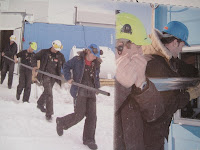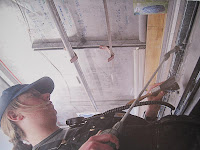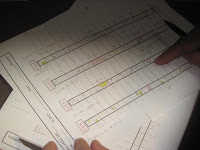Le fasi di studio delle carote di roccia dei sedimenti marini in Antartide del progetto ANDRILL è un tipico esempio di rigoroso e sistematico studio scientifico di avvenimenti climatici in cui si cerca di bring together the knowledge and skills of multiple disciplines: geophysics, drilling, sedimentology, geology, planning, petrology, paleontology, paleomagnetism, volcanology. For more information on the ANDRILL project is to disseminate education and for scientific research is going on
www.progettosmilla.it

The class began the experience by carefully reading the poster "deciphering of geological cores' Antarctica
 whose electronic version is on this site.
whose electronic version is on this site. Part of the class (science section) has analizzto with the teacher (Prof. L. Pinter) the instructional video n.11 " scegliere la zona del carotaggio ", anche perchè si è pretstato molto bene per una panoramica e un approfondimento sulla fisica delle onde per le indagini sismiche (che sta nel programma del quarto anno).
Alcuni importanti commenti a tale riguardo sono stati lasciati dagli allievi della IV liceo scientifico:
(...)
Ecco le fasi delle attività di labratorio:
1) La classe ha raccolto alcune informazioni essenziali dall'introduzione all'unità 3, dall'esame del poster e da uno dei video a riguardo, ovvero il video n.9 "incontra i perforatori". [il video n.10 "il flusso di lavoro della carota" non è stato visionato per consentire una libera deduzione delle informazioni dall'osservazione delle foto]
2) La classe ha esaminato una ad una le foto appesse a caso dall'insegnante alla lavagna, senza leggere l'informazione sul retro, commentandole una ad una.
3) Si è svolta una fase di discussione che ha prodotto una possibile sequenza delle fasi di lavoro, di perforazione e di studio.
4) si procede al confronto con la sequenza corretta e la classe commenta le eventuali differenze.
5) Gli allievi utilizzano la loro fanatasia peR produrre un tema immaginando di essere una roccia sotto al fondale oceanico in Antartide e raccontano una storia che descrive le loro avventure quando gli ANDRILLiani la perforano e la riportano in superficie per studiarla.
6) Students viewing the video # 10 " workflow carrot" to reorganize their knowledge,
7) and try one brief but comprehensive exposition of the sequence of drill;
8) finally expose their ideas on how they would interact with an audience of visitors who try to sort the photos of the work of coring.
- - - - - - - - - - - - - - - - - - - - - - - - - - - - - - - - - - - - - - -
1) the essential information from 'introduction to the unit 3, an examination of posters and a video about it, or the video No.9 "meets drillers' [reconstructed by Mattia Cubic and tidied by prof. Pinter]
I sedimenti sono frammenti di roccia, detriti che di solito si trovano sulla terra, nei fiumi, nei mari, ecc,.
Vi sono 200 scienziati più tecnici e docenti coinvolti per il progetto denominato ANDRILL,
il cui scopo è capire la storia climatica del nostro pianeta per poter meglio prevederne il futuro.
L'estrazione delle rocce, tramite carotiere, rispetta un ordine cronologico in cui è avvenuto una variazione nella estensione delle calotte antartiche a causa del cambio delle temperature.
Nelle rocce ci sono tracce dei cambiamenti climatici del passato.
La carota di roccia è un cilindro strtto lungo di rocce.
I ghiacciai producono sedimenti, che diventano rocce.
Si deduce il paesaggio passato analizzando filled with layers of sediment.
The chronological order is indicated by the upper layer is + young.
The drilling is done with a hollow tube, said core barrel, which is similar to a straw stuck into a cake.
One of the objectives is to discover how varied the amount of ice.
Several experts aim to develop models for what they found in the sediments and be notified of seeking an interpretation that will work for all scientific disciplines involved.
To find interesting rocks to drill through the ice and cold water marine and drilling the seabed oeanico hundreds of meters below sea level.
2) Here are the photos labeled with a capital letter for the rapid identification: A:

geologist who studies the geological cores
C:

loading and unloading of carrots
D:

store carrots
E:

analysis of carrot
F:

transverse subdivisions in many parts of the carrot
G:

transporting carrots
H:

microscopic analysis
I:

data collection analysis
J:

longitudinal sample
K:

disosizione of layers of rock in the appropriate tools
L:

are doing coring
M:

cleaning the carrots through a pump
N:

scholar who analyzes the samples of rock
O:

flags that indicate the age of rock
P:

are scanning the section
Q:

are analyzing sections
R:

preparation carrots
B:

corer, remove the tube for carrots
3) Here are the possible sequence - chosen by the class - with regard to the phases of drilling work and study:
GBRLCMFEKPAQOJDNHI


















4) Il confronto con la sequenza corretta e il commento delle eventuali differenze:
G-B-L-R-F-M-E-K-PA-Q-O-J-N-H-I-C-D


















5) Students use their imagination to produce a theme imagining a rock beneath the ocean floor in Antarctica and tell a story that describes their adventures when ANDRILLiani drilling and reported in area to study:
(...) [Eduard Prota]
(...) [Stefano Piasenti]
(...) [Mattia Cubic]
(...) [Giulia Salvadei]
( ...)
[Elisa Caligiuri]
(...) [?]
6) Students viewing the video # 10 " workflow carrot" to reorganize their knowledge,
7) and try one brief but comprehensive exposition of the correct sequence of the drill and its study:
(...)
8) ideas on how to interact with an audience of visitors who try to sort photos of the work Coring:
0 comments:
Post a Comment